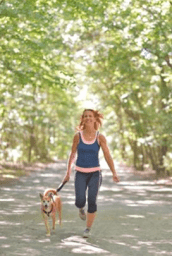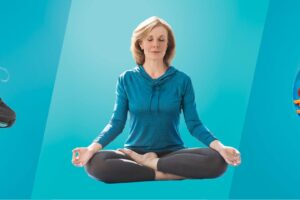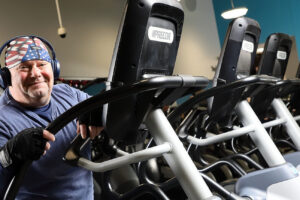Though Howell resident Heather Cooper had once been an active, outgoing person, her symptoms from early onset Parkinson’s disease began five years ago and got progressively worse. “I’d always been very adventurous and athletic and had even worked as a yoga instructor and at a ski resort managing a lodge, but by the summer of 2015, I couldn’t walk, my left arm hung, and I was always shaking,” the 46-year-old insurance analyst says. “I’d also gotten very anxious and became terrified to drive long distances.
 “While colleagues began noticing her symptoms and her condition took a toll on her work and social life, “it never crossed my mind that I might have Parkinson’s at my age,” Heather says of the disease. “It was an unexpected and scary diagnosis.”
“While colleagues began noticing her symptoms and her condition took a toll on her work and social life, “it never crossed my mind that I might have Parkinson’s at my age,” Heather says of the disease. “It was an unexpected and scary diagnosis.”
While her doctor immediately started her on targeted medication and physical therapy for Parkinson’s disease treatment, she also recommended that Heather work with a therapist trained in the Lee Silverman Voice Treatment (LSVT) ‘BIG®’ program—an exercise treatment protocol offered by LSVT-certified occupational and physical therapists to improve fine and gross motor function, both of which can be significantly impacted by Parkinson’s disease.
In November 2015, Heather sought out the expertise of therapists certified in this unique protocol within the OceanFirst Rehabilitation Center at CentraState. She ultimately came under the care of Karen Cohen, MPT, whose understanding of the program and more than 20 years of experience in the field of physical therapy resulted in a life-transforming experience for Heather.
“The BIG program is geared toward helping you have ‘big’ range of motion, because Parkinson’s causes everything to get smaller—the way you walk, turn your head, etc.,” Heather explains. “Parkinson’s causes you to stop moving and lose coordination.”
“The LVST BIG protocol is based on the principle that the brain has neuroplasticity and the potential to learn new neurological pathways for reorganization,” Cohen says. “Parkinson’s patients typically experience tremors and stiffness, and ultimately engage in slower and smaller range of motion—conditions that can get progressively worse. The LSVT BIG program can help improve symptoms for many patients.”
According to Cohen, the intensive program consists of hour-long sessions four times a week for four weeks and involves a set protocol of exercises that need to be followed exactly in order to create new neural pathways. “Patients need to do them every day, either once with us and once at home on therapy days or else twice on their own on non-therapy days,” Cohen says of the regimen of large-amplitude motions designed to break through old patterns of movement. LSVT BIG involves a number of specific exercises that are conducted during every session, such as motions involving reaching, crossing the midline, walking, etc.
“The therapist can progress the patient by adding additional tasks that pertain to that patient’s needs or else modify it back as needed,” Cohen explains. “Ultimately, the program works on functional mobility and incorporates balance, coordination, and some cognitive tasks because the activities of daily life involve multitasking.
A Life-Changing Experience
Since completing the BIG program at CentraState late last year, Heather cannot say enough about the impact it has had on her life.
“When I started the program with Karen, I had a difficult time doing basic exercises such as walking and turning my head, which had been unconscious movements before but now I couldn’t do them and it was frustrating,” Heather says. “By the end, however, I was ‘walking BIG’—taking big steps and swinging my arms. Karen also helped me multitask by having me count by twos or fives or naming animals for each letter of the alphabet with each step to make me think, and my balance definitely improved as well. It was amazing to be able to walk properly now.”
For Heather, the confidence she gained from the program resulted in tremendous emotional strides as well. “I was withdrawn when I first started the program and now I’m just the opposite,” shares the mother of a 15- and 20-year old. While she remains on specific medication for her symptoms, “my anxiety is much better and I recently drove to Philadelphia with no problem. I’m able to swim again and this June I even did a Mudderella race in Englishtown with my cousin and a friend and had a great time.” That 5-mile long women’s empowerment race incorporates 16 different obstacles. “We didn’t skip anything and did really well.”
Heather attributes much of her success to her therapist. “Karen was just amazing—so creative, patient, and attentive to my specific needs,” she says. “She knew just how to push me and literally taught me how to walk again.”
“Heather is such an inspiration,” Cohen says. “When she came in she was quiet and timid, her body was guarded, and she was scared about her diagnosis and what it might mean for her future. By the end, she was out walking, even boxing and sparring, and there was a brightness about her. She persevered, worked hard, followed the protocol, and never gave up. She pushed herself and, thanks to her strong will and dedication, truly finished strong and found she could have a life and do things she never thought she’d do again.”
Cohen says Heather’s story is important because there may be others out there in her age group with these issues who think there is nothing they can do about their condition. “As an adjunct to medication, you can learn to perform these daily exercises, engage in movement, and have the chance to significantly improve your quality of life,” she says. “The sooner that patients actively participate, especially at early onset, and follow the protocol, the better their chances of making positive functional changes.” Cohen adds that patients simply need to schedule an LSVT BIG initial evaluation and a therapist will assess their applicability for the program.
Living Every Day
Though Heather occasionally experiences pain and balance issues as a result of her condition, “I’m largely back to how I was and most days are good days,” she says. “Today, I’m very open about my condition so that I can help other people understand it and hopefully promote awareness about early onset Parkinson’s. Other programs I looked into were comprised largely of seniors and I felt so alone, so I was excited to learn about the BIG program at CentraState. I really wanted this program to work and it was exactly what I needed.”
Following her successful completion of the challenging but rewarding regimen, “I have my old self back again, and I want to live every day,” Heather shares. “I hope they find a cure for this, but in the meantime I take it day by day and enjoy my kids and life and try to be the best I can be. I’m especially grateful to Karen, and I feel like the BIG program helped me achieve my potential again.”





